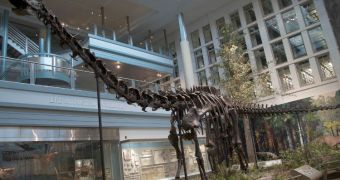An international collaboration of investigators announces in a new study that it was recently able to figure out how ancient herbivore dinosaurs fed, more than 150 million years ago. This was only made possible via the use of advanced technology, the group says.
Usually, the methods used to research this issue are employed for racing cars or airplanes design, the team goes on to say. However, they were recently repurposed in order to study very old dinosaurs, including the renowned massive herbivore Diplodocus.
Investigators at the University of Bristol and the Natural History Museum, both in the UK, led the international group that carried out the research. In addition to computed tomography (CT) scans, the specialists also used biomechanical modeling techniques to bring the dinosaur back to life.
In this manner, the team determined that the skull of Diplodocus was specifically adapted to strip leaves from tree branches. Details of how the team came to this conclusion appear in the July 16 issue of the renowned scientific journal Naturwissenschaften.
According to the fossil record, the Diplodocus could grow to be around 30 meters (99 feet) in length, and tipped the scales at 15 tons. After emerging in the Jurassic Period (199.6 to 145.5 million years ago), it quickly became one of the longest animals to have ever lived on Earth.
“Sauropod dinosaurs, like Diplodocus, were so weird and different from living animals that there is no animal we can compare them with. This makes understanding their feeding ecology very difficult,” explains Dr. Mark Young.
“That’s why biomechanically modeling is so important to our understanding of long-extinct animals,” adds the expert, who is a former student at both UB and the NHM. He explains that a technique called finite element analysis (FEA) was used to model various feeding behaviors.
One of the main conclusions in the new study is that eating the bark off of trees was most likely very stressful for the skull, so the Diplodocus most likely did not do this. Instead, it raked leaves from the top of the trees. Previous studies already showed it can raise on its hind legs.
“Using these techniques, borrowed from the worlds of engineering and medicine, we can start to examine the feeding behavior of this long-extinct animal in levels of detail which were simply impossible until recently,” adds NHM expert, Dr. Paul Barrett.

 14 DAY TRIAL //
14 DAY TRIAL //